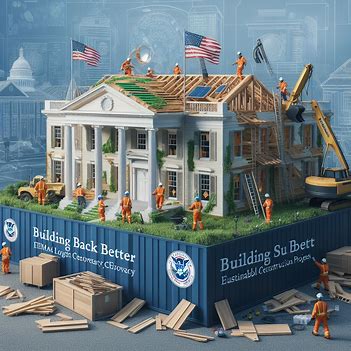
Building Back Better: Case Studies of FEMA's Long-Term Recovery Efforts and Sustainable Reconstruction Projects

Introduction
After disasters strike, communities often face the daunting task of rebuilding and recovering. The Federal Emergency Management Agency (FEMA) plays a crucial role in facilitating long-term recovery efforts and promoting sustainable reconstruction projects. This blog explores case studies of FEMA's initiatives, showcasing how communities are building back better after disasters.
Case Study 1: New Orleans, Louisiana (Hurricane Katrina)

Following the devastation caused by Hurricane Katrina in 2005, FEMA worked with local, state, and federal partners to support the long-term recovery of New Orleans. Through programs such as the Hazard Mitigation Grant Program (HMGP) and the Community Development Block Grant-Disaster Recovery (CDBG-DR) program, FEMA provided funding for infrastructure upgrades, flood protection measures, and affordable housing initiatives. Additionally, FEMA collaborated with community stakeholders to develop resilience plans and sustainable redevelopment strategies, ensuring that New Orleans would emerge stronger and more resilient in the face of future disasters.
Case Study 2: Joplin, Missouri (Tornado Recovery)

In 2011, an EF5 tornado struck the city of Joplin, Missouri, causing widespread destruction and loss of life. In the aftermath of the disaster, FEMA supported Joplin's recovery efforts through various programs and initiatives. FEMA provided funding for debris removal, infrastructure repairs, and the rebuilding of critical facilities such as schools and hospitals. Moreover, FEMA worked closely with local officials and community organizations to incorporate sustainability principles into the reconstruction process. This included implementing energy-efficient building standards, promoting green infrastructure projects, and investing in resilient design practices. As a result, Joplin was able to not only rebuild but also enhance its resilience and sustainability for future generations.
Case Study 3: Puerto Rico (Hurricane Maria)

In 2017, Hurricane Maria devastated Puerto Rico, causing widespread damage to homes, infrastructure, and the economy. FEMA's long-term recovery efforts in Puerto Rico have focused on rebuilding critical infrastructure, restoring essential services, and supporting economic revitalization. Additionally, FEMA has prioritized sustainable reconstruction projects aimed at reducing vulnerability to future disasters and enhancing the island's resilience to climate change impacts. Through partnerships with local communities, nonprofit organizations, and international agencies, FEMA continues to support Puerto Rico's recovery and rebuilding efforts, demonstrating a commitment to building back better.
Conclusion
FEMA's long-term recovery efforts and sustainable reconstruction projects serve as powerful examples of resilience and innovation in the face of adversity. By investing in infrastructure upgrades, promoting green building practices, and engaging with local communities, FEMA is helping to build more resilient and sustainable communities that can withstand future disasters. Through continued collaboration and investment, FEMA is paving the way for a brighter and more resilient future for all.
